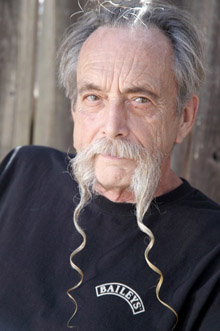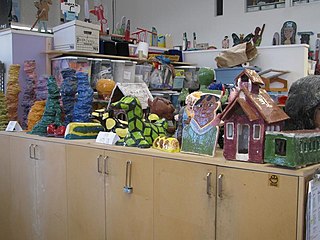
Wearable art, also known as Artwear or "art to wear", refers to art pieces in the shape of clothing or jewellery pieces. These pieces are usually handmade, and are produced only once or as a very limited series. Pieces of clothing are often made with fibrous materials and traditional techniques such as crochet, knitting, quilting, but may also include plastic sheeting, metals, paper, and more. While the making of any article of clothing or other wearable object typically involves aesthetic considerations, the term wearable art implies that the work is intended to be accepted as an artistic creation or statement. Wearable art is meant to draw attention while it is being displayed, modeled or used in performances. Pieces may be sold and exhibited.

Simon Vouet was a French painter who studied and rose to prominence in Italy before being summoned by Louis XIII to serve as Premier peintre du Roi in France. He and his studio of artists created religious and mythological paintings, portraits, frescoes, tapestries, and massive decorative schemes for the king and for wealthy patrons, including Richelieu. During this time, "Vouet was indisputably the leading artist in Paris," and was immensely influential in introducing the Italian Baroque style of painting to France. He was also according to Pierre Rosenberg, "without doubt one of the outstanding seventeenth-century draughtsmen, equal to Annibale Carracci and Lanfranco."
Tim Hawkinson is an American artist who mostly works as a sculptor.

Ida Applebroog was an American multi-media artist who was best-known for her paintings and sculptures that explore the themes of gender, sexual identity, violence, and politics. Applebroog was the recipient of multiple honors including the MacArthur Fellowship "Genius Grant", the College Art Association Distinguished Art Award for Lifetime Achievement, and an Honorary Doctorate of Fine Arts from the New School for Social Research/Parsons School of Design. Applebroog lived in New York City and is represented by Hauser & Wirth.
Hernan Bas is an artist based in Miami, Florida. He graduated in 1996 from the New World School of the Arts in Miami.

Galería de la Raza (GDLR) is a non-profit art gallery and artist collective founded in 1970, that serves the largely Chicano and Latino population of San Francisco's Mission District. GDLR mounts exhibitions, hosts poetry readings, workshops, and celebrations, sells works of art, and sponsors youth and artist-in-residence programs. Exhibitions at the Galería tend to feature the work of minority and developing country artists and concern issues of ethnic history, identity, and social justice.
Enrique Chagoya is a Mexican-born American painter, printmaker, and educator. The subject of his artwork is the changing nature of culture. He frequently uses shocking imagery, irony, and Mesoamerican icons to convey his point in his artwork. Chagoya teaches at Stanford University, in the department of Art and Art History. He lives in San Francisco.
Thomas Patrick Campbell is the director and CEO of the Fine Arts Museums of San Francisco, overseeing the de Young and Legion of Honor museums. He served as the director and CEO of the Metropolitan Museum of Art between 2009 and 2017. On 30 June 2017, Campbell stepped down as director and CEO of the Metropolitan Museum of Art under pressure and accepted the Getty Foundation's Rothschild Fellowship for research and study at both the J. Paul Getty Museum in Los Angeles and at Waddesdon Manor, in the UK.

Favianna Rodriguez is an American artist and activist known for her work in political posters and public art.
Nahum B. Zenil is a Mexican artist who often uses his own self-portrait as the principal model for a cultural critical interpretation of Mexico, especially concerning homosexuality and mestization. Zenil was born in 1947 in the state of Veracruz. In 1959, he enrolled at the Escuela Nacional de Maestros in Mexico City, from which he graduated in 1964. It was during this period in which Zenil became interested in painting. He later entered the Escuela Nacional de Pintura y Escultura in Mexico City in 1968. He is also one of the founding members of the Semana Cultural Gay, which occurs yearly at the Museo Universitario del Chopo. His art is often compared to that of Frida Kahlo, in which the self becomes the principal object of their paintings letting the viewer discover the artists as individuals as well as the broader social and cultural contexts in which they lived through the medium of self-portraiture.
Ellen Gallagher is an American artist. Her work has been shown in numerous solo and group exhibitions and is held in the permanent collections of many major museums. Her media include painting, works on paper, film and video. Some of her pieces refer to issues of race, and may combine formality with racial stereotypes and depict "ordering principles" society imposes.
Alberto Gironella was a self-taught Mexican painter born in Mexico City. Heavily influenced by the politics and artist in Mexico, he showcased his works in Brazil, United States, Spain, France, Japan, Sweden and Switzerland. In Mexico his works were in the Palace of Fine Arts and Museum of Modern Art, and the Carrillo Gil and Rufino Tamayo museums. Gironella also illustrated the book Terra Nostra by Carlos Fuentes. In 1960 he won the first prize of the Paris Biennial for Young Painters and the first prize of the Sixth Biennial of São Paulo, Brazil. Several of his later paintings were nudes, including several with either topless or fully naked women on beds either holding a classical guitar or one shown in the background such as Sanda as Carmen (1985).
Lari George Pittman is a Colombian-American contemporary artist and painter. Pittman is an Emeritus Distinguished Professor of Painting and Drawing at the UCLA School of the Arts and Architecture.

Clayton George Bailey, was an American artist who worked primarily in the mediums of ceramic and metal sculpture.
Adelheid Mers is a German visual artist, Professor, and the Chair of the Department of Arts Administration and Policy at the School of the Art Institute of Chicago, Chicago, IL. As an artist, Mers works through Performative Diagrammatics, a practice that includes elements of installation, facilitation with publics, and video. Her research draws on close work with others, exploring arts ecologies, and knowing differently, or epistemic diversity. Work takes place nationally and internationally, for example in residency, conference and exhibition settings.
Shizu Saldamando, is an American visual artist. Her work merges painting and collage in portraits that often deal with social constructs of identity and subcultures. Saldamando also works in video, installation and performance art. She has been featured in numerous exhibitions, has attained accolades like that of Wanlass Artist in Residence, and is a successful writer, tattoo artist, and social activist.

Creative Growth Art Center is a nonprofit arts organization, based in Oakland, California, that provides studios, supplies, and gallery space to artists with developmental, mental, and physical disabilities. It is one of the oldest and largest art center for people with disabilities in the world. It is currently located at 355 24th Street in Oakland, California.

Geri Montano, otherwise known as Geralyn Marie Montano, is a contemporary Native American artist who incorporates themes of Native American heritage, feminism, and societal issues into her work.
Diedrick Brackens is an American artist and weaver. Brackens is well known for his woven tapestries that explore African American and queer identity.
Damián Ortega is a Mexican visual artist, known for his contemporary sculpture, installation art, and mixed-media art. He lives in Mexico City and Berlin.







